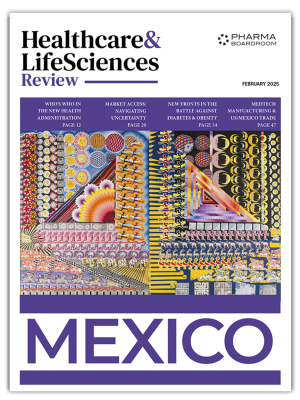Mexico
February 2025
Mexico’s healthcare and life sciences sector is at a pivotal moment. As a country with deep manufacturing expertise, a rapidly evolving regulatory landscape, and a strategic position at the heart of North America, Mexico is both a regional powerhouse and a critical player in the global healthcare ecosystem. But with opportunity comes challenge, and 2025 is set to be a defining year.
The new administration, under President Claudia Sheinbaum, inherits an ambitious healthcare agenda. The expansion of IMSS-Bienestar aims to provide broader coverage to uninsured populations, while new policies seek to balance affordability with access to innovation. Yet, with healthcare spending still hovering at just 2.5-3.1% of GDP—far below OECD and regional averages—funding constraints loom large. Will these ambitious reforms translate into tangible improvements for patients?
Meanwhile, market access remains a central concern. The country’s fragmented reimbursement pathways, regulatory bottlenecks, and shifting procurement models have long frustrated industry players. But positive change is on the horizon. The recent push to digitalize COFEPRIS and streamline approvals is a step in the right direction, and clinical trials continue to present an untapped opportunity, both for patients seeking early access to cutting-edge therapies and for the USD 4 billion economic boost they could provide.
Mexico’s private healthcare sector is also taking center stage. With public system inefficiencies persisting, a growing middle class is turning to private providers for faster and more reliable treatment. The country’s robust private hospital network, thriving medtech industry, and increasingly sophisticated diagnostics sector are becoming crucial in filling healthcare gaps and driving innovation.
At the same time, global investors are eyeing Mexico like never before. The nearshoring boom, spurred by geopolitical shifts and supply chain diversification, has positioned the country as a prime hub for pharma and medtech manufacturing. With record-high foreign direct investment (FDI) and increasing partnerships with multinational healthcare players, Mexico is proving its resilience and strategic importance in the Americas.
Despite the challenges, one thing is clear: Mexico’s healthcare sector is undergoing a transformation. The industry’s key stakeholders—policymakers, regulators, industry leaders, and international investors—are navigating a complex but opportunity-rich landscape.
This report delves into the realities behind the headlines, featuring insights from top industry voices and shedding light on the strategies shaping Mexico’s healthcare future.
Mexico’s healthcare and life sciences sector is at a pivotal moment. As a country with deep manufacturing expertise, a rapidly evolving regulatory landscape, and a strategic position at the heart of North America, Mexico is both a regional powerhouse and a critical player in the global healthcare ecosystem. But with opportunity comes challenge, and 2025 is set to be a defining year.
The new administration, under President Claudia Sheinbaum, inherits an ambitious healthcare agenda. The expansion of IMSS-Bienestar aims to provide broader coverage to uninsured populations, while new policies seek to balance affordability with access to innovation. Yet, with healthcare spending still hovering at just 2.5-3.1% of GDP—far below OECD and regional averages—funding constraints loom large. Will these ambitious reforms translate into tangible improvements for patients?
Meanwhile, market access remains a central concern. The country’s fragmented reimbursement pathways, regulatory bottlenecks, and shifting procurement models have long frustrated industry players. But positive change is on the horizon. The recent push to digitalize COFEPRIS and streamline approvals is a step in the right direction, and clinical trials continue to present an untapped opportunity, both for patients seeking early access to cutting-edge therapies and for the USD 4 billion economic boost they could provide.
Mexico’s private healthcare sector is also taking center stage. With public system inefficiencies persisting, a growing middle class is turning to private providers for faster and more reliable treatment. The country’s robust private hospital network, thriving medtech industry, and increasingly sophisticated diagnostics sector are becoming crucial in filling healthcare gaps and driving innovation.
At the same time, global investors are eyeing Mexico like never before. The nearshoring boom, spurred by geopolitical shifts and supply chain diversification, has positioned the country as a prime hub for pharma and medtech manufacturing. With record-high foreign direct investment (FDI) and increasing partnerships with multinational healthcare players, Mexico is proving its resilience and strategic importance in the Americas.
Despite the challenges, one thing is clear: Mexico’s healthcare sector is undergoing a transformation. The industry’s key stakeholders—policymakers, regulators, industry leaders, and international investors—are navigating a complex but opportunity-rich landscape.
This report delves into the realities behind the headlines, featuring insights from top industry voices and shedding light on the strategies shaping Mexico’s healthcare future.
See more














































